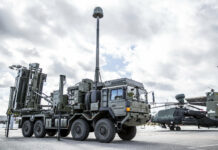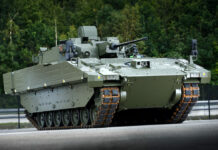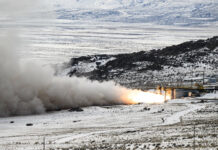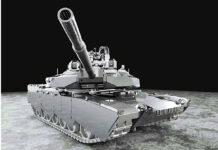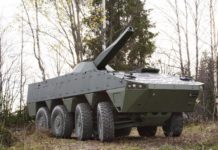After many years of neglect, an increasing number of users are now placing growing emphasis on their mortar systems, as for most infantry battalions these are the only indirect fire weapons under their direct control and can therefore rapidly respond to calls for fire support.
Recent mortar developments include 120mm turret-mounted mortars which can be integrated onto tracked and wheeled armoured platforms, and can be used for both the direct and indirect fire missions.
A good example is the Finnish Patria NEMO 120 mm turret-mounted mortar system which is already in service with the Kingdom of Saudi Arabia installed on a batch of General Dynamics Land Systems Canada Light Armoured Vehicle (8×8).
Further development by Patria has resulted in an integrated containerised NEMO 120mm which can be installed on an 8×8 cross-country truck chassis with another version on a naval craft already in service with the United Arab Emirates.
There is also a new generator of mortars that can be installed on light cross-country vehicles.
A typical example is the Spanish NTGS ALAKRAN Light Mortar Carrier (LMC) which is already in service in the Middle East integrated on a Toyota LAND CRUISER 4×4 platform, with the Ukraine also deploying the system integrated into a BARS 8 4×4 armoured personnel carrier. To reduce the recoil force when firing, the 120mm mortar and its associated baseplate is lowered to the ground over the rear of the platform. If required, the 120mm mortar barrel can be replaced by an 81mm mortar barrel and it is normally coupled to a computerised fire control system (FCS) to enable the system to come into action, carry out a fire mission and then redeploy to another position before being located by threat target acquisition systems.
In addition to the actual mortar, there have been significant improvements in the key areas of ammunition with many users now requiring mortar bombs to be insensitive munition (IM) compliant.
Mortars are traditionally an area effect weapon and in addition to firing high-explosive (HE) mortar bombs, also fire smoke and illuminating munitions. For 120mm mortars, rocket-assisted mortar bombs have been developed, and the requirement for increased accuracy and less collateral damage has led to the development and fielding of precision guided munitions (PGM) for use against high value targets.
In order to carry out a successful mortar engagement, the target has to be detected which can be via a mortar fire control team equipped with lightweight day/night observation devices, laser rangefinder, land navigation systems, and a communications link direct to the mortars, which are normally deployed in units of three or six, or to a higher chain of command.
The mortar is just one indirect fire weapon, with the others being conventional tube artillery systems and rocket launchers but with the increased emphasis on joint firing. There are today other weapons that can be used to neutralise a given target including fast jets, attack helicopters, unmanned aerial vehicles and, in some cases, naval gunfire support.
A higher level would have a wider range of target acquisition capabilities at their disposal than a mortar fire control team, including locating radars, sound ranging devices, radars, UAV’s, and electronic warfare, to name but a few.
An increasing number of countries now have Joint Terminal Attack Controllers (JTAC) can call in not only close air support assets, but other indirect fire assets to enable targets to be more rapidly engaged.
In the past, mortars have always been controlled by the infantry, but some countries now place all mortars under the direct control of the artillery as they have a wider range of target acquisition capabilities.
Christopher F. Foss has been writing on armoured fighting vehicles and artillery systems since 1970 and until recently was editor of Jane’s “Armoured Fighting Vehicles” and the artillery element of “Jane’s Artillery and Air Defence”. He has also lectured on these subjects in many countries as well as chairing conferences all over the world. He has also driven over 50 tracked and wheeled AFVs.






